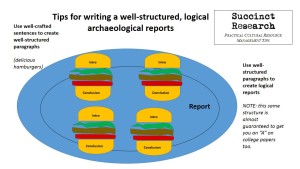 I nearly lost my first job in cultural resource management archaeology because I didn’t know how to write technical reports.
I nearly lost my first job in cultural resource management archaeology because I didn’t know how to write technical reports.
During my first week on the job, my boss asked me to work on an archaeological research design the company was preparing. I spent that afternoon preparing an annotated bibliography based on Historical Archaeology volumes and other peer-reviewed journal articles that my supervisor actually liked. She was impressed by what I’d put together on such short notice and gave me a rare word of encouragement. “Good job.”
I felt all warm and fuzzy inside; overjoyed that I was doing a good job.
Six months later, I found myself sitting at my desk—still reading references and old CRM reports at the office at 12:30 AM with no end in sight— fraught with anxiety about my imminent firing. I’d completed several reports to that point, none of which met the approval of my boss or the other report editors without some extensive editing. They disliked a lot of my content, were frustrated by my grammar, disappointed at my command of Microsoft Word, and shocked at my poor composition.
Each report was coated comments in red ink or was a Word file where each page was filled with dozens of suggestions in track changes. I was spending almost as much time editing my reports as I did researching and writing them. In college, I’d received high marks for my writing. Here, I’d been warned that I would be out of a job if I didn’t learn how to write.
At one point one of the technical editors asked me, “How can such a smart guy be so sh*tty at writing?” Indeed. How could I be doing so poorly?
I learned how to write by thinking of hamburgers
I wasn’t the only young CRMer at the company who was struggling with their technical writing skills. The company was expanding at that time and the PIs hired a group of smart technicians and crew chiefs who were responsible for writing their own reports. Each draft was reviewed by the PIs and other technical editors. The report didn’t even get formatted until the text was flawless.
Most of the folks doing the writing were young careerists a few years out of school. We’d written papers for class and maybe some artifact analysis sections but none of us had much less experience with professional technical writing. You could tell based on the quantity of edits each one of our reports demanded.
Editing and re-writing reports was hurting the company’s bottom line, so the PIs hired a consultant to host a technical writing workshop. The goal was the cut down on the time spent editing so we could do more thorough research and save the company more money. The things I learned in this short four-hour workshop have helped my career ever since. And, it’s all based on the idea that quality paragraphs should resemble delicious hamburgers.
The anatomy of a hamburger=the anatomy of a good technical writing paragraph
Here’s the gist of what I learned: All paragraphs should be composed of quality sentences that comprise quality paragraphs. Each paragraph should have an introduction sentence, support sentences, and a concluding sentence. Basic stuff I’d learned years before but had moved away from throughout the years. I’ve included a PDF of the proper mechanics for writing paragraphs for CRM reports that will cut down on the amount of structural editing in your technical writing.
Download your PDF here (SR_Hamburger_Writing_Diagram)
(FYI: This is the basic structure of every single form of technical writing in the English language. Emails, memos, even Facebook posts will be more understandable if you use this hamburger technique.)
(PS: This basic structure will also dramatically improve your grades on college essays and reports. In fact, you will out-finesse most of your classmates at least until graduate school by using this technique. SPOILER ALERT: It’s one factor that helped me get an “A” on every single graduate school essay at the PhD level.)
Quality, readable paragraphs in technical writing have three parts:
- The introduction sentence tells the reader what this paragraph is going to be about. It also tells you what you are going to write about. This is the beginning of the thought you will address in this paragraph. This is the top bun of the hamburger, without which you can’t properly hold and consume a tasty burger.
- The supporting sentences back up the claims made in the introductory sentence. Think of these as the toppings and patty in the burger. It wouldn’t be a hamburger without toppings so these support sentences really make your paragraphs sizzle.
- The conclusion sentence ends your thought and recaps what you’ve said in the paragraph. Think of it as the mirror image of your introduction sentence and the bottom bun of the hamburger. You don’t need to restate what you wrote in the introduction word-for-word, but you do need to signal to the reader that this particular thought is done.
The writing in technical reports, academic journal articles, and essays should be modular. By design, this technique makes each paragraph modular. Each hamburger should be like a Lego brick that you can move around and stack in different combinations. If you use the hamburger technique, each of the thoughts and ideas you express in your report will form small bricks that you can move around or eliminate if necessary.
I know, you already know this…
Many of the people reading this blog post already know about the hamburger writing technique. It may not have been explained in this fashion, but you guys already know about proper paragraph structure. It should have been part of your English classes in the 8th Grade or high school (I know I learned this whole hamburger thing at the same time as learning how to diagram sentences when I was 13-years-old).
Nevertheless, most of us fail to use the method in our writing. How do I know? Because I keep seeing horribly written paragraphs in journal articles and CRM reports all the time. Here are some indications that the paragraph was not written in hamburger format:
It is too long— In technical writing, a paragraph that takes up an entire page is way too long. Whenever I see this in a report, I know the author was asked to add information to an existing paragraph, was trying to jam too much info into one paragraph, or didn’t notice they were covering more than one concept in a single paragraph.
Don’t write long paragraphs because they are grueling to read. Good, hamburger-style paragraphs are only 2—7 sentences. Make a new paragraph if you find yourself filling up an entire page with your paragraphs.
There is no introduction sentence— I see this most often in artifact analysis sections. An author simply starts describing artifact categories and types without telling us why we need to know this information. Why does it matter that you recovered 33% red chert flakes versus 10% Glass Buttes obsidian? Why does it matter that you didn’t identify any decorated ceramic sherds? Without an introduction sentence, I’ll never know; unless you tell me in the conclusion which is tantamount to cooking a difficult-to-eat and difficult-to-sell open-faced hamburger.
There is no conclusion sentence— This is like breaking up with your significant other by simply not calling him anymore. How do I know your thought is finished? With a conclusion sentence. Punctuation can tell me you’re done, but a bottom bun does it much better.
Unfinished thoughts— This is another version of not having a conclusion sentence, but it may also signify that part of the paragraph has been cut or moved to another part of the report. Usually, I notice this when a paragraph from a previous section is finally explained much later in the report. You get to the conclusion and FINALLY see the piece of information you wanted to know, then you go back to the place where it should have been and see one or more paragraphs with no conclusion sentence. You can’t leave the reader hanging. If you cut off a piece of your paragraph, you’ve got to add a bottom bun to make your hamburger complete.
Support sentences that don’t support— A proper hamburger only works when the contents are harmoniously combined. You have to add the right support sentences in order for your introduction and conclusion to make sense. Sentences describing stuff that isn’t in the intro sentence should be moved elsewhere or used to build a separate paragraph. Hamburger writing needs all three parts so your support sentences have to corroborate what you say in the intro sentence. This is very important because it helps make your writing logical and modular.
Hamburgers are the key
If you’ve been reading this blog for long you’ve probably noticed I use the hamburger method almost all the time. The style of technical writing used in cultural resource management archaeology should always be written in the hamburger format because it’s logical, functional, and allows us to better describe complicated information.
I started using the hamburger technique because I was a horrible technical writer even though I’d done well in college and had actually taken a technical writing course as an undergraduate. School can’t always prepare you for what you’ll need to know after graduation, which is especially true for technical writing. Learning how to be a good CRM writer takes practice but it also takes technique. My writing was fine for college but it was not good enough to maintain a steady income. I had to change if I was going to pay my bills by doing archaeology.
It is likely that I would have eventually started using the hamburger technique had I survived in the industry long enough. But, my writing was catapulted forward as soon as I started employing this technique while crafting cultural resource management technical reports. Less time was spent editing my work which allowed me to spend more time on research, which is the reason why any of us want to do archaeology. This change happened almost overnight for every one of us that attended the workshop.
Even though some of you may already know about this, I encourage you to download the PDF (SR_Hamburger_Writing_Diagram) and share it with students or other co-workers who may need help with their cultural resource management archaeology writing. What techniques do you use to make yourself a better writer? Please, write a comment below or send me an email.
Check out Succinct Research’s most recent publication Blogging Archaeology. Full of amazing information about how blogging is revolutionizing archaeology publishing. For a limited time you can GRAB A COPY FOR FREE!!!! Click Here
 “Resume-Writing for Archaeologists” is now available on Amazon.com. Click Here and get detailed instructions on how you can land a job in CRM archaeology today!
“Resume-Writing for Archaeologists” is now available on Amazon.com. Click Here and get detailed instructions on how you can land a job in CRM archaeology today!
 Small Archaeology Project Management is now on the Kindle Store. Over 300 copies were sold in the first month! Click Here and see what the buzz is all about.
Small Archaeology Project Management is now on the Kindle Store. Over 300 copies were sold in the first month! Click Here and see what the buzz is all about.
Join the Succinct Research email list and receive additional information on the CRM and heritage conservation field.
Get killer information about the CRM archaeology industry and historic preservation.




